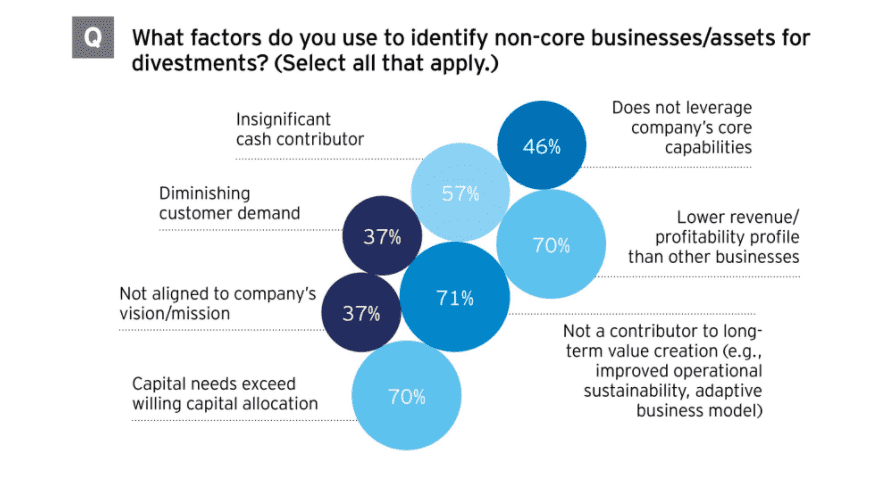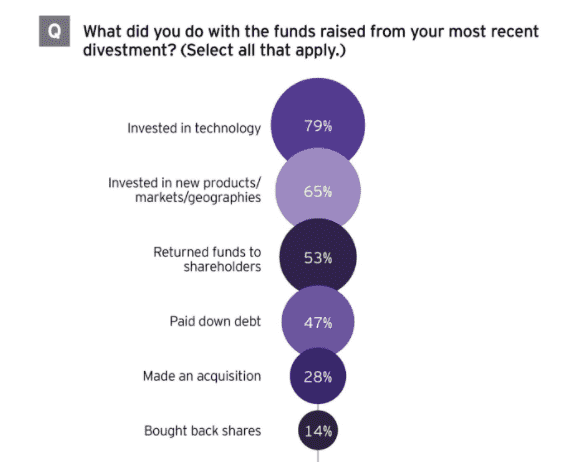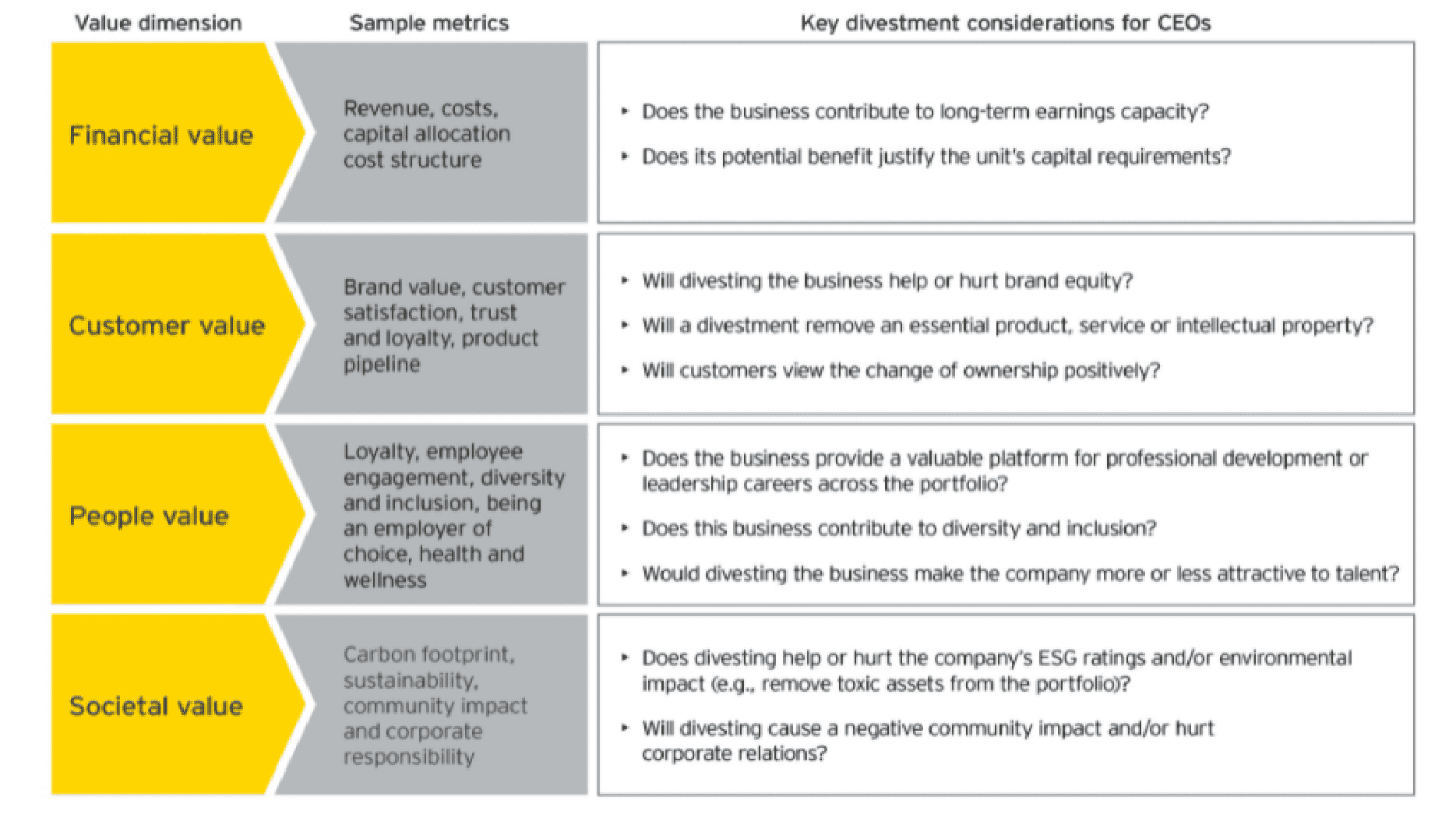There is no time to sit still as the need for — and the challenges of — divestments grow.
- In the latest 2021 EY Global Corporate Divestment Study, 76% of respondents expect the continued effects of the pandemic to accelerate divestment plans.
- CEOs admit that pursuing divestments and reaping the benefits can be challenging.
Companies across the globe are failing to meet expectations for their divestment’s sales price, timing and how they affect the valuation multiple of the remaining business (RemainCo), the 2021 EY Global Corporate Divestment Study finds. Nearly 8 out of every 10 companies (79%) say they didn’t meet price expectations in their most recent divestiture, especially in Asia-Pacific, where 87% of executives say they did not get the price they expected. At the same time, 56% globally say their most recent divestment did not generate the valuation multiple impact for RemainCo they planned (71% in the Americas).
Divestments can underperform when they are treated as one-off decisions based on short-term financial factors, rather than being closely aligned with the overall corporate strategy. In fact, nearly 60% of CEOs acknowledge they should provide better guidance as to what they regard as core and non-core businesses.
Key divestment drivers across the globe
The pandemic is affecting deals across the globe, driving companies to raise funds to invest in technology and meet new customer needs — or prompting companies to sell poorly performing businesses. Nearly all companies (94%) confirm that changes to the technology landscape are directly influencing divestment plans, up from 59% pre-pandemic. And two-thirds of companies say their most recent divestment was triggered by suboptimal returns in the divested business.
Environmental, social and governance (ESG) issues are also an emerging factor. Globally, 46% of sellers say these issues directly influence divestment plans, though ESG is currently a much larger factor in Asia-Pacific (84%) than in EMEA (47%) and the Americas (14%). Regulatory changes that require companies to reduce their carbon footprint, especially in Europe, are now influencing divestment decisions, while companies in the Americas ponder the impact on management and workforce diversity when carving out or spinning off a business.
Use your divestment strategy to determine which assets are core
As companies face a myriad of geopolitical, macroeconomic and operational challenges, the decision of what and when to divest starts with strategy.
CEOs need to determine which businesses no longer help drive the company’s strategy — which are deemed non-core — by taking a broad view on how a company generates long-term value for stakeholders. Yet 39% still struggle to define which businesses in their portfolios are core or non-core, and only 37% consider alignment to the company vision or mission a factor in identifying divestments. This suggests that, in some cases, strategy may not be the driving force behind decisions, with short-term financial factors instead taking the lead.

Companies should consider several key elements about how each business supports the corporate strategy in order to determine which are core:
- The business’s market and underlying growth in demand
- Its ability to leverage the company’s core competencies
- The value proposition compared with that of competitors
- Alignment to the company’s vision or mission
- Potential for long-term value creation from a financial, customer, people or societal standpoint
Triggering events like the pandemic can crystallize thinking about the long-term value narrative and the opportunity for divesting. Stakeholders may rally behind a divestment decision if they are shown how it will free up capital to invest in areas such as technology that can help increase operational efficiencies, improve the customer experience and streamline decision-making.
Reinvest capital into growth areas
Funds raised by selling businesses are often invested in core capabilities that support long-term value creation, such as technology (79%) and new markets, products or geographies (65%), to better position RemainCo for the future.
For example, one global media company divested the majority of a key business, after deciding to align the company around three distinct customer segments. The business, with its broader horizontal approach across industries, no longer fit this strategy and would be more attractive to another owner.
Part of the funds from the divestment were set aside to fund strategic acquisitions to bolster key growth segments.

Define how each business unit contributes to long-term value
The EY definition of long-term value goes beyond the traditional measure of financial value, as that view neglects key metrics that are becoming more important to stakeholders and boards — and which can often now affect financial value. These include how a business is viewed by and affects customers, employees and society.
Analysis should measure and communicate long-term value drivers across four dimensions: financial value, customer value, people value and societal value. These drivers — with variations by industry — affect shareholder value and access to capital.

Together, these quantitative and qualitative factors address a full ecosystem of stakeholders — from shareholders, employees, customers and suppliers to regulators, communities and society at large. CEOs can use these factors, when considered as part of the long-term strategy, to understand if an asset is in the best hands or should be divested.
Widen your definition of value drivers
As market conditions and stakeholder demands change, companies can revisit value drivers. Even well-performing businesses can be prime candidates to carve out or spin off if they no longer fit the long-term strategy, as they tie up capital that could be better deployed on investments that have a more substantial impact on long-term value.
For example, the consumer goods company Unilever has a vision “to make sustainable living commonplace” and uses portfolio optimization as one of the key components with a focus on high-growth product categories such as personal care, functional nutrition and plant-based foods as well as key markets such as the US, India and China. To that end, Unilever has made divestments in areas that are not part of its long-term strategy as it seeks to “accelerate long-term sustainable value.” One example is the sale of its Alsa baking and dessert preparation business in 2018.

Rally stakeholders with a consistent narrative
CEOs can rally employees, customers and investors behind divestments by showing how the portfolio change supports the company’s strategy and can help drive long-term value. They can also share a vision of how RemainCo can be enhanced and reimagined as a result of the divestment. A strategic narrative also helps overcome inevitable legacy emotion and internal politics, which can be powerful forces in debate over company structure. Yet nearly half (44%) say they have difficulty explaining the reasoning behind divestments to the board and key stakeholders.
Stakeholder messaging should demonstrate how the business has been evaluated. This can include go-to-market approaches, cost synergies from related products and technology, or geographic coverage.
Key takeaways for CEOs
- Have a clear view on each business’s market and underlying growth in demand, competitive advantage, alignment to the company’s vision and potential for long-term value creation from a financial, customer, people and societal standpoint.
- Pursuing divestments can help accelerate investments in technology, new products and geographies to meet customer needs and fuel new growth for RemainCo.
- Even a strong-performing business that does not fit with your strategy might be tying up capital that could be better deployed on higher-impact investments. Communicating this can help rally stakeholders behind a decision to carve out or spin off a business.
The article was first published here.
Photo by Alexander Mils on Unsplash.

 5.0
5.0 





















